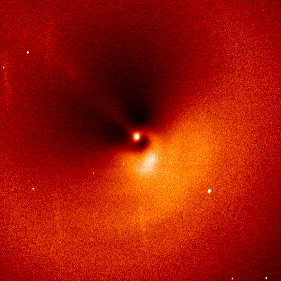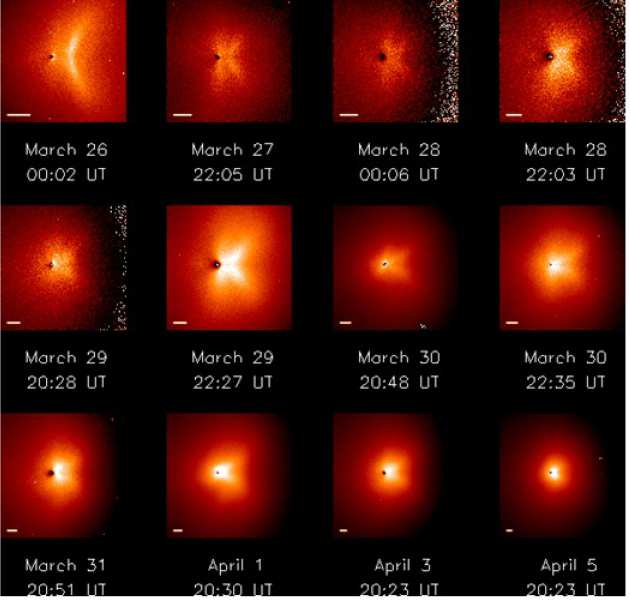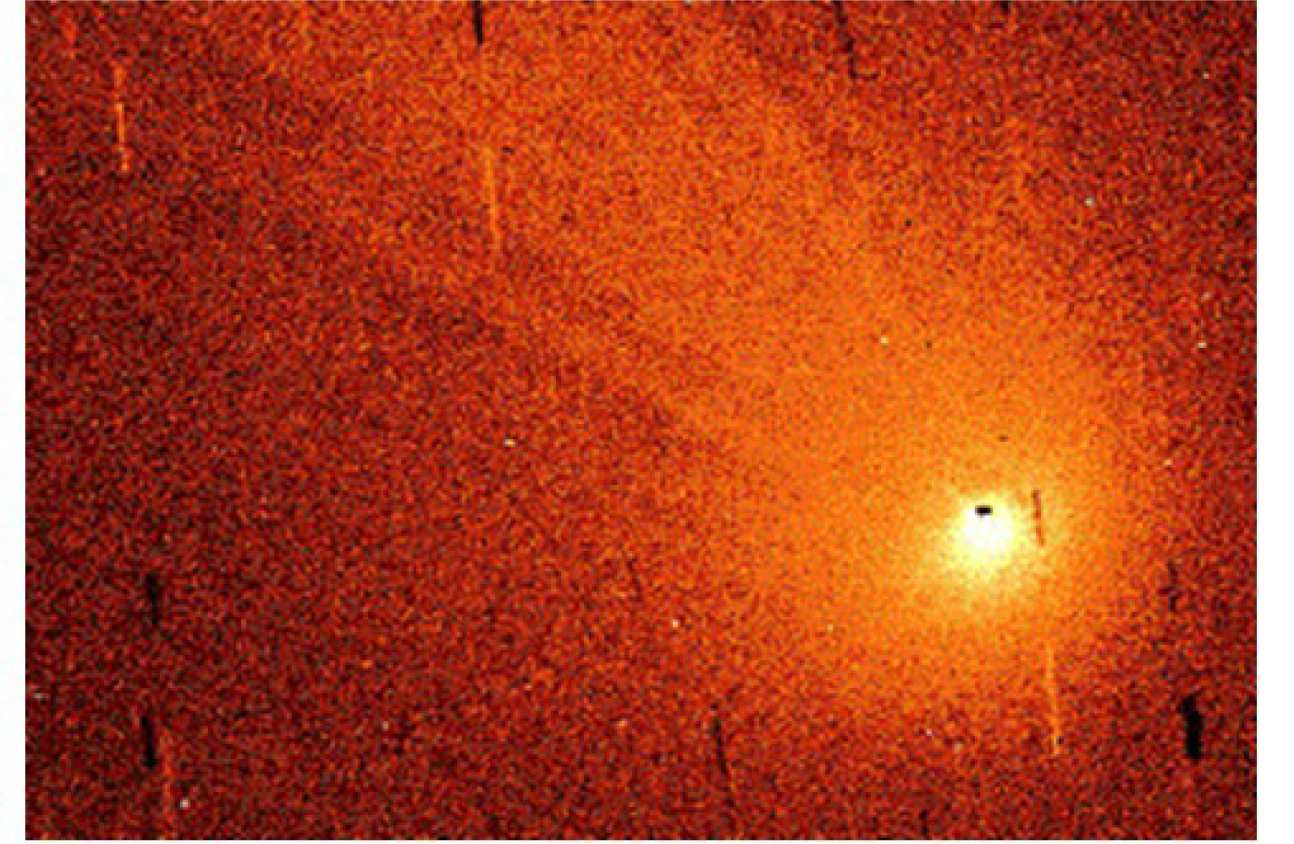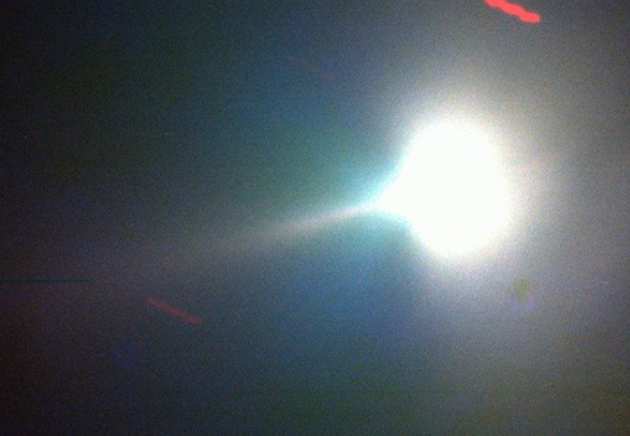 Because of its close approach to the Earth, a lot could be learnt about things happening very close to its nucleus. As well as optical and infrared observations, radar was used to probe the nucleus. These observations indicated that it was around 2-3 km across.
Because of its close approach to the Earth, a lot could be learnt about things happening very close to its nucleus. As well as optical and infrared observations, radar was used to probe the nucleus. These observations indicated that it was around 2-3 km across.
(Right) An animation of the region surrounding the nucleus of Comet Hyakutake for several hours on April 1/2, 1996. The sequence was obtained using the 0.6m Radcliffe Telescope at the University of London Observatory, by Geraint Jones (then of the Mullard Space Science Laboratory), and Steve Fossey of the University of London Observatory. The nucleus (which can't be resolved on this scale) is at the centre of the image. The Sun was towards the lower right. Curved jets dust can be seen leaving the sunward side of the nucleus. Short vertical lines are background stars. Bright points are cosmic ray hits on the CCD detector.
Hyakutake's nucleus was found to be fragmenting - a train of mini-nuclei was found, showing that sizeable pieces were breaking off the nucleus.
 Left is an enhanced image of the region near Hyakutake's nucleus, acquired between 00:08 and 00:14 UT on March 28, 1996 at the Nordic Optical Telescope, La Palma, Canary Islands. The Sun was towards the left, and the image shows a region around 36000km across. The nucleus is located in the largest white region around a quarter of the way along the image. Curved jets of gas and dust emanating at the nucleus are visible on the sunward side. Nine nuclear fragments are detectable with careful analysis, the largest of which appears at the centre of this image. The faint diagonal streaks are star trails. The image was enhanced by smoothing using a Gaussian filter, and then subtracting the logarithm of the smoothed image from the logarithm of the original.
Left is an enhanced image of the region near Hyakutake's nucleus, acquired between 00:08 and 00:14 UT on March 28, 1996 at the Nordic Optical Telescope, La Palma, Canary Islands. The Sun was towards the left, and the image shows a region around 36000km across. The nucleus is located in the largest white region around a quarter of the way along the image. Curved jets of gas and dust emanating at the nucleus are visible on the sunward side. Nine nuclear fragments are detectable with careful analysis, the largest of which appears at the centre of this image. The faint diagonal streaks are star trails. The image was enhanced by smoothing using a Gaussian filter, and then subtracting the logarithm of the smoothed image from the logarithm of the original.
As the nucleus was fragmenting, gas was being released both from the nucleus itself and from the fragments (large and small) which had been broken away from it. The interaction of the flows from these two sources formed a structure of higher neutral gas number density on the anti-sunward side of the nucleus. When viewed from the side (around March 27), this structure appeared as an arc.
 The image on the right shows the development of the CN (cyanogen) arc over several days, as recorded at the Nordic Optical Telescope. The Sun is towards the left in each frame, and the white scale bar measures 1000km at the comet. Note that the phase angle (Earth-Comet-Sun) was changing during this time, from 71° on March 26, 91° on March 27 to 111° on April 5.
The image on the right shows the development of the CN (cyanogen) arc over several days, as recorded at the Nordic Optical Telescope. The Sun is towards the left in each frame, and the white scale bar measures 1000km at the comet. Note that the phase angle (Earth-Comet-Sun) was changing during this time, from 71° on March 26, 91° on March 27 to 111° on April 5.
Other observations of the neutral gas in the comet, using optical and radio observations, revealed several molecules that hadn't been detected at comets previously.
One of the biggest discoveries made was the detection of X-rays from the comet by the Rosat spacecraft. Comets had not been previously regarded as being sources of X-rays.
The part of the comet which most interests Ulysses scientists is the ionized (plasma) component. During the close approach to the Earth, Hyakutake's ion tail was spectacular; stretching tens of degrees across the sky.
The image below is of Hyakutake obtained with the 0.6m Radcliffe telescope at the University of London Observatory at 23:36 UT on April 1, 1996, covering a region around 159000 by 106300km at the comet. A continuum (dust) image was subtracted from the (H2O+ & dust) image to isolate the light from the water ions. The Sun was towards the lower right, so the solar wind was flowing towards the upper left. The short bright and dark lines are star trails. The broad, diffuse lines are cometary tail rays - a phenomenon which so far has not been satisfactorily explained, but are generally believed to trace the magnetic field lines of the solar wind as it is convected through the comet.

 Image on the right shows a true-colour image taken on the morning of March 27th, 1996 using the 0.6m Radcliffe Telescope at the University of London Observatory - the comet was at the time exactly side-on to the Earth. The view is around 35000km across. The blue features on either side of the tail are neutral gas arcs (see below).
Image on the right shows a true-colour image taken on the morning of March 27th, 1996 using the 0.6m Radcliffe Telescope at the University of London Observatory - the comet was at the time exactly side-on to the Earth. The view is around 35000km across. The blue features on either side of the tail are neutral gas arcs (see below). Because of its close approach to the Earth, a lot could be learnt about things happening very close to its nucleus. As well as optical and infrared observations, radar was used to probe the nucleus. These observations indicated that it was around 2-3 km across.
Because of its close approach to the Earth, a lot could be learnt about things happening very close to its nucleus. As well as optical and infrared observations, radar was used to probe the nucleus. These observations indicated that it was around 2-3 km across. Left is an enhanced image of the region near Hyakutake's nucleus, acquired between 00:08 and 00:14 UT on March 28, 1996 at the
Left is an enhanced image of the region near Hyakutake's nucleus, acquired between 00:08 and 00:14 UT on March 28, 1996 at the  The image on the right shows
The image on the right shows 